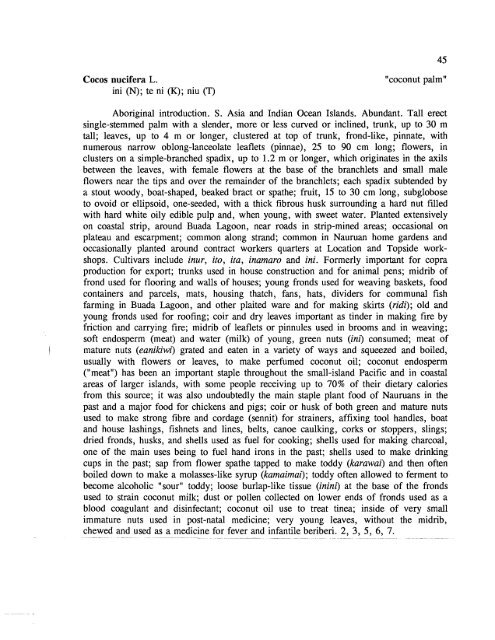atoll research bulletin no. 392 the flora of - Smithsonian Institution ...
atoll research bulletin no. 392 the flora of - Smithsonian Institution ...
atoll research bulletin no. 392 the flora of - Smithsonian Institution ...
You also want an ePaper? Increase the reach of your titles
YUMPU automatically turns print PDFs into web optimized ePapers that Google loves.
Cocos nucifera L.<br />
ini (N); te ni (K); niu (T)<br />
"coconut palm"<br />
Aboriginal introduction. S. Asia and Indian Ocean Islands. Abundant. Tall erect<br />
single-stemmed palm with a slender, more or less curved or inclined, trunk, up to 30 m<br />
tall; leaves, up to 4 m or longer, clustered at top <strong>of</strong> trunk, frond-like, pinnate, with<br />
numerous narrow oblong-lanceolate leaflets (pinnae), 25 to 90 cm long; flowers, in<br />
clusters on a simple-branched spadix, up to 1.2 m or longer, which originates in <strong>the</strong> mils<br />
between <strong>the</strong> leaves, with female flowers at <strong>the</strong> base <strong>of</strong> <strong>the</strong> branchlets and small male<br />
flowers near <strong>the</strong> tips and over <strong>the</strong> remainder <strong>of</strong> <strong>the</strong> branchlets; each spadix subtended by<br />
a stout woody, boat-shaped, beaked bract or spa<strong>the</strong>; fruit, 15 to 30 cm long, subglobose<br />
to ovoid or ellipsoid, one-seeded, with a thick fibrous husk surrounding a hard nut filled<br />
with hard white oily edible pulp and, when young, with sweet water. Planted extensively<br />
on coastal strip, around Buada Lagoon, near roads in strip-mined areas; occasional on<br />
plateau and escarpment; common along strand; common in Nauruan home gardens and<br />
occasionally planted around contract workers quarters at Location and Topside workshops.<br />
Cultivars include inur, ito, ita, inamaro and ini. Formerly important for copra<br />
production for export; trunks used in house construction and for animal pens; midrib <strong>of</strong><br />
frond used for flooring and walls <strong>of</strong> houses; young fronds used for weaving baskets, food<br />
containers and parcels, mats, housing thatch, fans, hats, dividers for communal fish<br />
farming in Buada Lagoon, and o<strong>the</strong>r plaited ware and for making skirts (ridi); old and<br />
young fronds used for ro<strong>of</strong>ing; coir and dry leaves important as tinder in making fire by<br />
friction and carrying fire; midrib <strong>of</strong> leaflets or pinnules used in brooms and in weaving;<br />
s<strong>of</strong>t endosperm (meat) and water (milk) <strong>of</strong> young, green nuts (ini) consumed; meat <strong>of</strong><br />
I mature nuts (eanikiwi) grated and eaten in a variety <strong>of</strong> ways and squeezed and boiled,<br />
usually with flowers or leaves, to make perfumed coconut oil; coconut endosperm<br />
("meat") has been an important staple throughout <strong>the</strong> small-island Pacific and in coastal<br />
areas <strong>of</strong> larger islands, with some people receiving up to 70% <strong>of</strong> <strong>the</strong>ir dietary calories<br />
from this source; it was also undoubtedly <strong>the</strong> main staple plant food <strong>of</strong> Nauruans in <strong>the</strong><br />
past and a major food for chickens and pigs; coir or husk <strong>of</strong> both green and mature nuts<br />
used to make strong fibre and cordage (sennit) for strainers, affixing tool handles, boat<br />
and house lashings, fishnets and lines, belts, ca<strong>no</strong>e caulking, corks or stoppers, slings;<br />
dried fronds, husks, and shells used as fuel for cooking; shells used for making charcoal,<br />
one <strong>of</strong> <strong>the</strong> main uses being to fuel hand irons in <strong>the</strong> past; shells used to make drinking<br />
cups in <strong>the</strong> past; sap from flower spa<strong>the</strong> tapped to make toddy (karawai) and <strong>the</strong>n <strong>of</strong>ten<br />
boiled down to make a molasses-like syrup (kamaimai); toddy <strong>of</strong>ten allowed to ferment to<br />
become alcoholic "sour" toddy; loose burlap-like tissue (inini) at <strong>the</strong> base <strong>of</strong> <strong>the</strong> fronds<br />
used to strain coconut milk; dust or pollen collected on lower ends <strong>of</strong> fronds used as a<br />
blood coagulant and disinfectant; coconut oil use to treat tinea; inside <strong>of</strong> very small<br />
immature nuts used in post-natal medicine; very young leaves, without <strong>the</strong> midrib,<br />
chewed and used as a medicine for fever and infantile beriberi. 2, 3, 5, 6, 7.<br />
- -~ -- - - ~~<br />
~ ~ -- ~<br />
- ~- ~-~~~~~ ~ - - ~<br />
---- ~<br />
~~ ~ ~

















